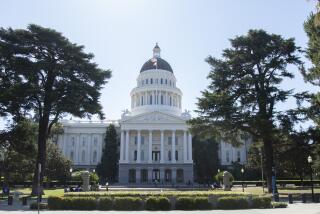‘Gov. No’ Rules Sacramento in a Hail of Vetoes
- Share via
Question: Who is California’s most powerful state legislator, Assembly Speaker Bob Hertzberg (D-Sherman Oaks) or Senate President Pro Tem John Burton (D-San Francisco)?
Answer: Neither. The most powerful state legislator is Gov. Gray Davis, and it’s his actions that will be most important after the Legislature adjourns later this summer.
The source of Davis’ legislative success lies with his aggressive use of the veto. With his ability to say “no,” the governor is virtually guaranteed the final word on all proposed legislation.
Of the 1,454 bills that reached his desk during the 1999-2000 legislative session, Davis signed 1,088 and allowed another four to become law without his signature. At the same time, he vetoed 362 proposals, one-fourth of the total. That’s a record unequaled by any California governor in modern times. Legislators may be elected to make laws, but no legislator can claim control over the outcome of 25% of the action in Sacramento, and that’s exactly what Davis did this past year.
With his use of the veto, Davis pared more than $2 billion from the state budget. Key reductions included $210 million from health and social services programs, $176million from higher education initiatives, $173 million from K-12 education commitments and $151million from juvenile and adult corrections programs. But he also emerged as the most important architect in the shaping of state public policies. Davis’ vetoes incorporated areas ranging from bills on juvenile disabilities to dietary supplements to employment conditions to Internet gambling.
Although governors in 49 of the 50 states are empowered with various forms of vetoes, what makes the veto so unusual in California is the near certainty that it will stick. Overturning the governor’s veto requires agreement from a full two-thirds of the legislators in each house; that means 54 of the 80 Assembly members and 27 of the 40 senators.
The application of the two-thirds requirement in California allows the governor unparalleled legislative power. No veto has been overturned in nearly 25 years. This raises the question of whether the state Constitution’s distribution of power is fair, regardless of who is governor and the merits of any particular veto.
Political checks and balancesare supposed to allow each branch to have enough clout that no one side will dominate completely. But with the near certainty of the governor’s veto in California, parity is gone. When the governor vetoes, the game is over, period.
Any chief executive is entitled to the veto as an appropriate tool of office. But with the quirky rules shaping the governor’s veto in California, this tool is more than the ability to prod additional negotiations; rather, it’s a virtual mallet that allows the chief executive to hammer shut any further discussions. And with one-fourth of last year’s legislation disposed of so definitively, it leads one to wonder whether the checks and balances in this state are a bit out of whack.
More to Read
Get the L.A. Times Politics newsletter
Deeply reported insights into legislation, politics and policy from Sacramento, Washington and beyond. In your inbox twice per week.
You may occasionally receive promotional content from the Los Angeles Times.








